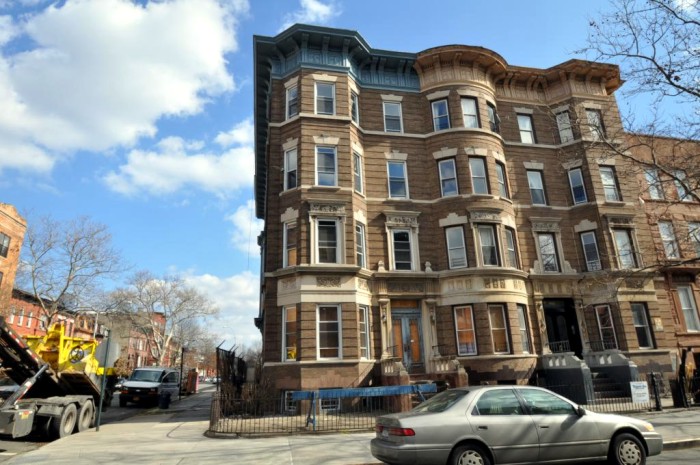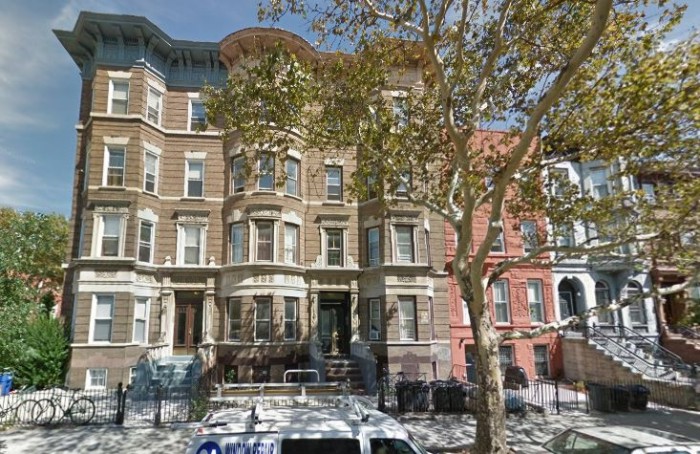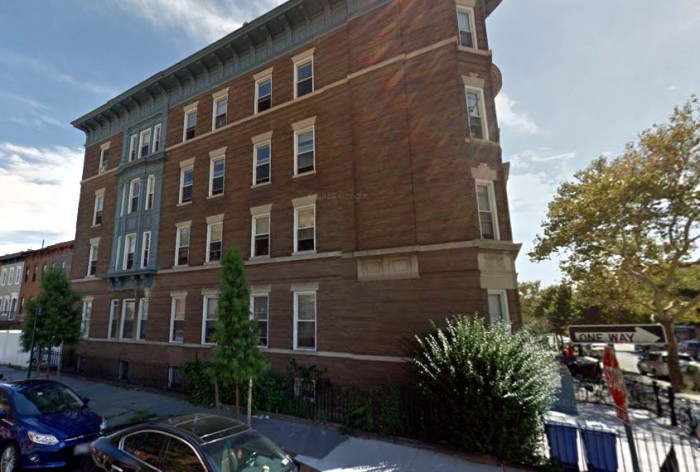Building of the Day: 291-293 Stuyvesant Avenue
Brooklyn, one building at a time. Name: Flats buildings Address: 291-293 Stuyvesant Avenue Cross Streets: Halsey and Hancock Streets Neighborhood: Stuyvesant Heights Year Built: 1898 Architectural Style: Renaissance Revival Architect: Axel Hedman Other Buildings by Architect: in Stuy Hts – row houses on Stuyvesant Avenue, Jefferson Avenue, Immanuel Baptist Church, now Union Baptist, on Decatur…


Brooklyn, one building at a time.
Name: Flats buildings
Address: 291-293 Stuyvesant Avenue
Cross Streets: Halsey and Hancock Streets
Neighborhood: Stuyvesant Heights
Year Built: 1898
Architectural Style: Renaissance Revival
Architect: Axel Hedman
Other Buildings by Architect: in Stuy Hts – row houses on Stuyvesant Avenue, Jefferson Avenue, Immanuel Baptist Church, now Union Baptist, on Decatur St. Also row houses, flats buildings and apartment buildings all over brownstone Brooklyn.
Landmarked: Yes, part of Stuyvesant Heights Expansion Historic District (2013)
The story: When most people think of the housing stock in Brooklyn, they probably think of row houses. The second most popular kinds of buildings in those same row house neighborhoods would have to be flats buildings, especially in the later brownstone neighborhoods of Crown Heights, Park Slope, Bedford and Bedford Stuyvesant, Prospect Heights and parts of Clinton Hill. In my old neighborhood of Crown Heights North, you couldn’t walk down very many blocks that didn’t have one or two flats buildings, and my block in particular, on Pacific Street, there were twelve. Ironically enough, most of the twelve were designed by this guy – Axel Hedman.
Axel was the king of late 19th century flats buildings. Other architects designed them as well, but Axel probably did more of them, and arguably did them better. This duo was built in 1898. Hedman really came into his own after the 1893 Chicago Worlds Exhibition which brought us the White Cities Movement. Most of his row houses and flats were designed in the Renaissance Revival style, as were these, with classical motifs in limestone and light colored brick. He had a signature style, and although others may have copied him, I can generally spot a Hedman flat in a minute.
Flats buildings were very popular in our neighborhoods beginning in the 1880s, although a few pre-date that. They were built as middle class multiple unit dwellings, something above a lowly tenement, for those who may not be able to afford an entire house, but could afford to live in a good neighborhood. They were walkups, and still are, no matter where they are. Most double flats buildings had a wing on either side of a central hall, with an apartment on each side, on all four floors; generally 8 in total.
Single flats buildings had one apartment per floor off the stairway and hall. This complex has one of each, a single on the corner, next door to a double. Hedman, as always designed his facades beautifully, with undulating bays, with different shapes, lots of details and elegant cornices. Inside, his flats were well laid out, with wainscoted dining rooms with a fireplace, columns and pier mirrors in the double parlors.
A look at the newspapers tells us that both of these buildings were filled with people who covered the broad spectrum of the middle class. There were doctors, the former VP and general manager of the old Kings County Elevated Railroad, a chauffeur, teachers, clerks and merchants, among others. Stuyvesant Avenue was a posh address, and some of the people living her in the early 20th century were well off enough for servants and summering outside of the city.
One resident of 291 was William Tell Goundie. He and his wife and teenaged son lived in the second floor apartment in 1912. One day in April, two burglars broke into their apartment in the middle of the day when they were not home and robbed them blind. They were most interested in the contents of the bedrooms, and stole jewelry, as well as all of Mr. and Master Goundie’s clothing.
The inventory came to five suits from the father and two from the son, all of the ties and handkerchiefs, a coat, and shirts. They went through all of the closets and wardrobes and took everything in suitcases they found in a closet. The thieves took a brand new suit that Mrs. Goundie had just brought home for her husband, which he had never worn. They didn’t take any of her clothing, and passed on her furs. All of the family’s clothing was thrown on the bed and picked over. Since a neighbor saw them come in the building, it was hoped he’d be able to pick them out of the precinct’s rogue’s gallery.
Much later, in 1941, Stuyvesant Avenue was now home to many of Brooklyn’s black elite. One of the apartments in 293 belonged to Miss Marie Migkens. She was an organist and was about to become the first African American to perform an organ recital at Town Hall, in Manhattan. Miss Migkens was a graduate of the Guilmant Organ School, one of the most prestigious organ schools in America, also in Manhattan.
She was a member of Abyssinian Baptist Church in Harlem, and was a member of the American Guild of Organists. The concert was a part of a series sponsored by the David I. Martin branch of the National Association of Negro Musicians, an association founded in 1919 to promote Negro artists in the concert and classical music professions. It’s always interesting to find out who lived in the great buildings in our communities.
(Photo:Christopher Bride for Property Shark)







What's Your Take? Leave a Comment